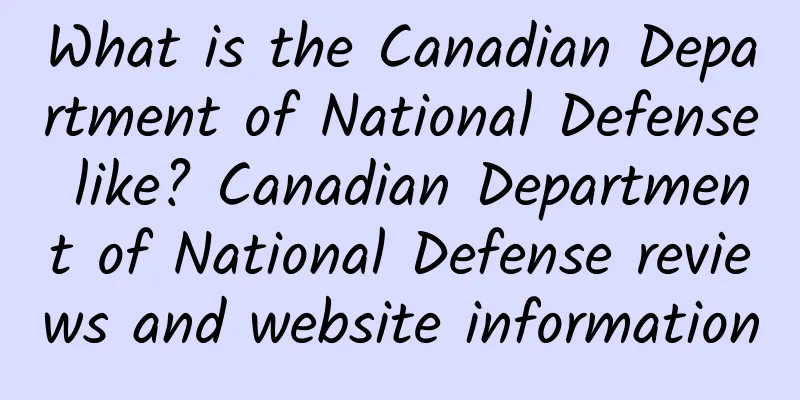What is the Canadian Department of National Defense like? Canadian Department of National Defense reviews and website information

|
What is the Canadian Department of National Defence website? The Canadian Department of National Defence (English: Department of National Defence, French: Ministère de la Défense nationale) is a Canadian government department established in 1923. It is in charge of Canada's national defense affairs and commands the Canadian Army. Website: www.forces.gc.ca Canadian Department of National Defense: Protecting national interests and global peaceThe Department of National Defence (DND; French: Ministère de la Défense nationale) is one of the core departments of the Canadian federal government and was established in 1923. As the highest institution in charge of Canada's defense affairs, it is not only responsible for formulating and implementing Canada's defense policy, but also directly controls the Canadian Armed Forces. The official website of the Canadian Department of National Defence is www.forces.gc.ca . This website is not only an important channel for the public to obtain defense-related information, but also a window to showcase Canada's national security strategy, military modernization process and international peacekeeping contributions. Historical background and original intentionThe history of the Canadian Department of National Defense can be traced back to after the First World War. During the war, Canada actively participated in the European battlefield, and after the war, it realized that a more unified and efficient organization was needed to manage national defense affairs. In 1923, the Canadian government integrated the originally scattered military departments into a whole and established the Canadian Department of National Defense. This move aims to strengthen the country's defense capabilities while ensuring the efficient allocation and use of resources. Since then, Canada's Department of National Defense has been tasked with protecting national sovereignty, maintaining territorial integrity, promoting regional stability, and participating in international peacekeeping operations. Over time, the Department of National Defense has adapted to new security challenges, including nuclear deterrence during the Cold War, the fight against terrorism after 9/11, and in recent years, cyber threats and the potential impact of climate change on the Arctic region. Functions and ResponsibilitiesThe main responsibilities of the Canadian Department of National Defence cover a variety of areas, which together form its core mission - to protect the interests of Canada and its people while contributing to global peace and security. The following are the main functions of the Department of National Defence:
These functions not only reflect the professionalism and comprehensiveness of the Canadian Department of National Defense, but also reflect the multiple roles it undertakes in the context of globalization. Organizational StructureThe Canadian Department of National Defense has a complex and efficient organizational structure consisting of multiple levels and departments to ensure that policy making, resource management and operational command can be seamlessly connected. The following are the main components of the Department of National Defense: Minister's OfficeThe Department of National Defence is led by the Minister of National Defence, a position usually nominated by the Prime Minister and approved by Parliament. The Minister of National Defence oversees the operations of the entire department and reports to Parliament. In addition, there is a Deputy Minister of National Defence who is responsible for day-to-day management and administration. Canadian ForcesAs the executive branch of the Department of National Defense, the Canadian Armed Forces is its most important component. The military is divided into three main branches: the Army, the Navy, and the Air Force. Each branch has its own headquarters and chain of command, but they work together under the unified leadership of the Department of National Defense. Other key sectors
This multi-tiered organizational structure enables the Department of Defense to remain flexible and responsive in a rapidly changing security environment. Official website: www.forces.gc.caThe official website of the Canadian Department of National Defense , www.forces.gc.ca , is an important platform for the public to understand the activities and policies of the department. The website has rich and diverse content, covering everything from defense policy to military life. The following are some of the main sections: News & AnnouncementsThe website regularly publishes press releases, media statements and important announcements to keep the public updated on the latest developments in the Ministry of Defense. Whether it is the delivery of a new weapon system or the progress of an international peacekeeping mission, detailed information can be found here. Defense PolicyThe website provides the full text of important documents such as the Strong, Secure, Engaged Defense Policy Review to help users understand Canada's defense strategic goals. In addition, there is a special page explaining how the Department of National Defense responds to emerging threats such as cyber attacks and climate change. Careers and RecruitmentFor those who wish to join the Canadian Armed Forces, the website provides detailed recruitment information, including enlistment requirements, training programs and benefits. In addition, there are support services designed specifically for veterans to help them transition smoothly into civilian life. Transparency and AccountabilityTo enhance public trust, the website also publishes annual budget reports, audit results, and performance evaluation data, which demonstrate how the Department of Defense manages public funds effectively and achieves its stated goals. International cooperation and global contributionAs a member of NATO and a long-time participant in UN peacekeeping operations, Canada’s Department of National Defense plays an important role in global security affairs. Here are some key areas of collaboration: Cooperation under NATOCanada is one of the founding members of the North Atlantic Treaty Organization (NATO) and has always actively participated in the activities of the alliance. The Ministry of National Defense has strengthened interoperability with its allies by sending troops to participate in joint exercises and deploying rapid reaction forces. In addition, Canada has deployed a battle group in Eastern Europe to support the defense needs of the Baltic countries. UN Peacekeeping OperationsCanada has been a major contributor to UN peacekeeping operations since the 1950s. Peacekeepers from the Department of National Defence are active in Africa, the Middle East and Southeast Asia, working to mitigate conflicts, protect civilians and restore social order. Although the number of peacekeepers has declined in recent years, Canada has pledged to increase its participation in the coming years. Fighting terrorismIn the face of global terrorist threats, the Canadian Department of National Defense has worked closely with other countries to combat extremist organizations. For example, in Iraq and Syria, the Canadian military has participated in air strikes and provided training and support to local armed forces. Future Prospects and ChallengesAlthough the Canadian Department of National Defense has made remarkable achievements in the past few decades, it still faces many challenges in the future. First, with the rapid development of technology, emerging threats such as cyber attacks, artificial intelligence and unmanned systems are becoming increasingly prominent, requiring the Department of National Defense to accelerate the pace of digital transformation. Second, the potential impact of climate change on the Arctic region has also brought new security issues, and the Department of National Defense needs to strengthen its monitoring and defense capabilities in the region. In addition, the Department of Defense must deal with budget constraints and human resource shortages. How to achieve military modernization with limited resources while meeting the needs of domestic and international missions will be an important issue in the coming years. ConclusionAs a core pillar of national security, the Canadian Department of National Defense not only protects Canada's sovereignty and interests, but also makes positive contributions to global peace and stability. Through its official website www.forces.gc.ca , the public can learn more about the work and achievements of the Department of National Defense. In the face of future challenges, the Department of National Defense will continue to uphold an innovative spirit and a cooperative attitude and work tirelessly to build a safer world. |
<<: How is the New Zealand government? New Zealand government reviews and website information
>>: What is the Frankfurt Book Fair like? Frankfurt Book Fair reviews and website information
Recommend
Abarth car_How is Abarth? Abarth car_Abarth review and website information
Abarth & C. Spa is an Italian automobile compa...
What is Dagestan State University like? Dagestan State University reviews and website information
What is the website of Dagestan State University? ...
How to make boat porridge? Steps of making boat porridge
Tingzai porridge is the most famous snack in Guan...
How is the Burkina Faso newspaper Le País? Burkina Faso newspaper Le País reviews and website information
What is the website of Le Pays? Le Pays is a famou...
What are the effects and functions of jackfruit core
Jackfruit is a unique fruit produced in tropical ...
Steps to prepare frozen saury
The cooking method of saury is similar to many ot...
How to make delicious shrimps? Step-by-step tutorial on how to make delicious shrimps
Shrimp is a delicious seafood, rich in nutrition ...
Can I eat leeks if I have stomach problems? Can I eat leeks if I have stomach problems?
Leek is a dish that we often eat. It is rich in n...
Chicken Liver Porridge
How much do you remember about chicken liver porr...
How to grow dragon blood tree? How to grow and propagate dragon blood tree
Nowadays, people are more and more aware of beaut...
How is ATR? ATR review and website information
What is ATR? ATR is an Italian-French joint ventur...
How to make Sichuan chili oil How to make Sichuan chili oil step by step tutorial
Sichuan chili oil is a common dish. In fact, you ...
How is ZWS Real Estate? ZWS Real Estate Reviews and Website Information
What is Silverstein Properties? Silverstein Proper...
What is Google Wedding like? Google Wedding reviews and website information
What is Google Weddings? Google Weddings is a wedd...
The efficacy and function of Coprinus comatus and the steps of making Coprinus comatus
The appearance of Coprinus comatus is similar to ...









